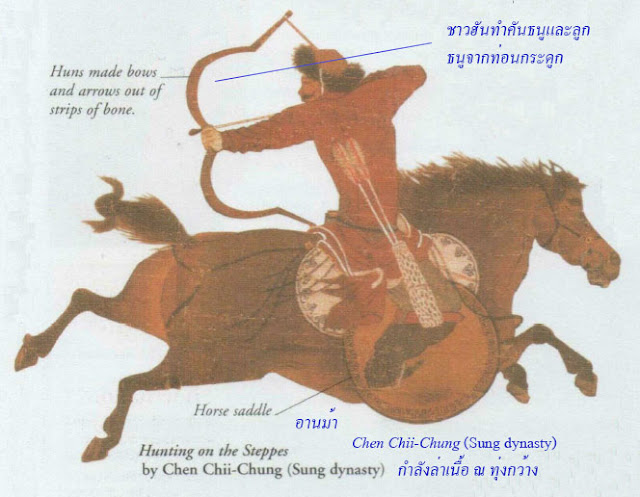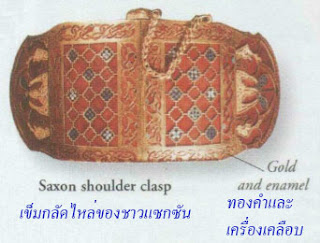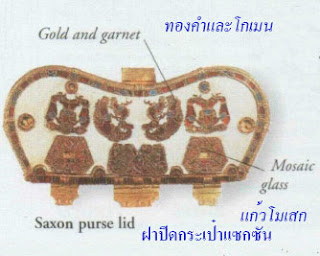BARBARIANS
To THE
ANCIENT GREEKS, all foreigners or outsiders were known
as barbarians, but from the 3rd century on,
this term was increasingly applied to nomadic mounted
tribespeople from Asia, eastern Europe, and parts of
Germany, such as the Huns and Goths. Organized into fearsome cavalry armies, these so-called
barbarians caused havoc in their search for land, and
were finally responsible for the collapse of the western
Roman Empire.
|
พวกอนารยชน
ชาวกรีกโบราณเรียกคนต่างถิ่นหรือคนนอกดินแดนทั้งหมดว่า
อนารยชน ทว่านับตั้งแต่ศตวรรษที่ 3 เป็นต้นมา คำนี้ใช้กับชนเผ่าเร่ร่อนที่ชอบขี่ม้าจากทวีปเอเชีย
ชาวยุโรปตะวันออกและบางส่วนของเยอรมนี เช่น ชาวฮันและชาวกอทมากขึ้น อนารยชนดังกล่าวเหล่านี้มีการจัดการกองทัพได้อย่างน่ากลัว
สร้างความหายนะในขณะที่แสวงหาดินแดน และในที่สุดก็มีส่วนรับผิดชอบต่อการล่มสลายของจักรวรรดิโรมันตะวันตก
|
|
Who were the
barbarians?
To most Europeans,
barbarian tribes included Huns and Avars (from
Asia), and Saxons, Vandals, and Goths (from Germany). Huns migrating from Asia into
Europe caused fear among the resident Germanic tribes,
who then poured in huge numbers across the Roman
Empire's frontiers. In a short
time, this migration led to the fall of the empire.
|
พวกอนารยชนคือใคร?
เผ่าอนารยชนที่ชาวยุโรปส่วนใหญ่เรียกขาน
ประกอบไปด้วย ชาวฮันและชาวอาวาร์ (จากทวีปเอเชีย) กับชาวแซกซัน ชาวแวนดัล และชาวกอท
(จากเยอรมนี) ชาวฮันอพยพจากทวีปเอเชียเข้าไปสู่ทวีปยุโรปก่อให้เกิดความกลัวในกลุ่มชนกลุ่มชนเจอร์แมนิก
(ซึ่งเป็นบรรพบุรุษของชาวเยอรมัน อังกฤษ สวีเดน นอร์เวย์ เดนมาร์กในปัจจุบัน) ซึ่งเป็นเจ้าถิ่น
ซึ่งขณะนั้นได้หลั่งไหลอพยพข้ามชายแดนจักรวรรดิโรมันจำนวนมหึมา ในช่วงเวลาสั้น ๆ
การอพยพครั้งนี้ได้นำไปสู่การล่มสลายของจักรวรรดิ
|
|
Huns
The Huns were a
nomadic Mongol people from the high plains, or steppes,
of Central Asia who invaded southeastern, Europe in c.370. Fierce in battle
and famous for their skill on horseback, they conquered
the Ostrogoths and drove the Vandals and
other tribes westward. Under the leadership of Attila they reached their zenith, ravaging the
Byzantine Empire and invading Gaul (modern France). In the 5th and 6th centuries, the White Huns, a related
people, raided Persia (Iran) and
northern India.
|
ชาวฮัน
ชาวฮันคือชาวมองโกลที่ชอบเร่ร่อนจากที่ราบสูงหรือที่ราบกว้างใหญ่ของเอเชียกลางรุกรานทวีปยุโรปทางตะวันออกเฉียงใต้
ในศตวรรษที่ 370 ชาวฮันมีความโหดร้ายในการทำสงครามและมีชื่อเสียงในด้านทักษะการขี่ม้า
ได้พิชิตชาวออสโตรกอทและขับไล่ชาวแวนดัลกับชนเผ่าอื่น ๆ ไปทางตะวันตก ภายใต้การนำของอัตติลา
ชาวฮันมีความรุ่งเรืองถึงจุดสุดยอด ด้วยการทำลายจักรวรรดิไบแซนไทน์และรุกรานกอล
(ฝรั่งเศสในปัจจุบัน) ในศตวรรษที่ 5 และ 6 ชาวฮันผิวขาว ซึ่งเป็นญาติกันได้เข้าโจมตีเปอร์เซีย
(อิหร่าน) และอินเดียตอนเหนือ
|
|||
Catalaunian Plains
The Huns were deadly
in battle as mounted archers. They
made short bows of bone, which were light and easy to
use while on horseback. They also fought with sabres at
close quarters. Under Attila, the Huns were victorious
many times, but in 451, they were finally defeated by the Romans and their allies at the Catalaunian Plains,
Gaul (now Chalons-sur-Marne,
France).
|
ทุ่งราบคาตาเลาเนียน
ชาวฮันมีความร้ายกาจในการทำสงครา
เป็นนักแม่นการยิงธนูบนหลังม้า พวกเขาทำคันธนูสั้น ๆ จากกระดูกซึ่งเบาและง่ายต่อการใช้ในขณะอยู่บนหลังม้า
ชาวฮันยังต่อสู้ด้วยดาบโค้งในระยะกระชั้นชิดได้ด้วย ขณะที่อัตติลาเป็นผู้นำ ชาวฮันได้รับชัยชนะหลายครั้งหลายครา
แต่ในที่สุด ในปี ค.ศ. 451 (พ.ศ. 994) ชาวฮันก็พ่ายแพ้ต่อชาวโรมันและพันธมิตรของตนเอง
ณ ทุ่งราบคาตาเลาเนียน ดินแดนกอล (ปัจจุบันคือ ชาลง-ซูร์-มาร์น ประเทศฝรั่งเศส)
|
Attila the Hun
Attila (c.406-453) became
king of the Huns in 434 jointly with his brother Bleda, whom he murdered in 445. Attila
united his people into a vast horde based in Hungary,
then waged campaigns to win land and tribute from the Roman and Byzantine empires. Short and crafty, the so-called "Scourge of God" was cruel to his enemies but fair to his own people. He died — possibly of poison
- on his wedding night.
|
อัตติลาเดอะฮันหรืออัตติลาจอมอนารยชน
อัตติลา (มีชีวิตระหว่าง ค.ศ. 406 –
453 = พ.ศ. 949 – 996 อายุ 47 ปี) เป็นราชาของชาวฮันในปี
ค.ศ. 434 (พ.ศ. 977) ร่วมกับน้องชายของตนเองชื่อ
เบลดาที่ถูกเขาสังหารในปี ค.ศ. 445 (พ.ศ. 988) อัตติลารวบรวมผู้คนจำนวนมากมายมหาศาลตั้งที่มั่นในฮังการี
ครันแล้ว ก็ทำสงครามยึดดินแดนและเครื่องบรรณาการจากจักรวรรดิโรมันและไบแซนไทน์ “แส้แห่งพระเจ้า”
ดังกล่าว (เป็นสมญานามที่ชาวโรมันเรียก อัตติลา) เป็นคนเตี้ยและมีเล่ห์เหลี่ยม มีความโหดร้ายต่อกองทัพของเขาแต่ยุติธรรมต่อประชาชนของเขาเอง
เขาเสียชีวิต
อาจเป็นไปได้ว่าจะถูกวางยาพิษ ในคืนแต่งงานของเขา
|
|
Ostrogoths and
Visigoths
The Ostrogoths were
a Germanic tribe on the Black Sea who were related to the Visigoths from the Danube area. After the Roman Empire fell in 476, the Visigoths adopted Christianity, and
translated the Bible from Latin into a "Gothic" script, which was used for
centuries in German printing.
|
ออสโตรกอทและวิซิกอท
ชาวออสโตรกอทคือกลุ่มชนเจอร์แมนิกบริเวณทะเลดำมีความสัมพันธ์กับชาววิซิกอทจากบริเวณแม่น้ำดานูบ
หลังจากจักรวรรดิโรมันล่มสลายในปี ค.ศ. 476 (พ.ศ. 1019) ชาววิซิกอทก็นำเอาศาสนาคริสต์มานับถือและแปลคัมภีร์ไบเบิลจากภาษาละตินเป็นอักษรกอทิกที่ใช้ตีพิมพ์เป็นภาษาเยอรมันเป็นเวลาหลายศตวรรษ
|
|
Notre-Dame Gargoyles, Paris, France
ปนาลีแห่งวิหารน็อทร์-ดาม ปารีส ฝรั่งเศส
|
||
Gothic architecture
Many medieval
churches and cathedrals were built in the Gothic style. The highly decorative details, such as
gargoyles, were believed by Renaissance artists to be "barbarous" when compared
with the simplicity of older Roman
buildings. So the artists named them
after the Gothic tribes that overran Rome.
|
สถาปัตยกรรมกอทิก
วัดและโบสถ์ที่สำคัญในยุคกลางมากมายสร้างในรูปแบบของกอทิก
รายละเอียดประดับประดาชั้นสูง เช่น ปนาลี (ศิลปะหัวรูปสัตว์ประหลาดที่เป็นปากท่อต่อจากรางน้ำฝน)
เชื่อกันว่าเป็นฝีมือของจิตรกรยุคฟื้นฟูศิลปวิทยาที่เป็นอนารยชน
เมื่อเปรียบเทียบกับความเรียบง่ายของสิ่งก่อสร้างของโรมันยุคเก่า ดังนั้น
จิตรกรจึงได้ตั้งชื่อศิลปะเหล่านั้นตามเผ่ากอทิก (คือกลุ่มชนเจอร์แมนิก) ที่เข้าบุกรุกโรม
|
|
|
Saxons
"The barbarians drive
us to the sea, and the sea drives us back to the
barbarians; one way or another we die." So wrote a group of 5th-century Britons to their former masters in Rome. The seafaring barbarians
threatening them were Saxons, Angles,
and Jutes —Germanic tribes of skilled
craftworkers and farmers who conquered
and settled stretches of fertile Britain
from c.500.
|
|
แซกซัน
กลุ่มชนชาวอังกฤษยุคศตวรรษที่ 5
ได้เขียนหนังสือให้กับผู้เชี่ยวชาญยุคก่อนในโรมไว้ว่า “พวกอนารยชน ได้ขับไล่พวกเราไปยังทะเล
และชาวทะเลก็ขับไล่พวกเรากลับไปหาพวกอนารยชน”
พวกอนารยชนที่เป็นชาวทะเลซึ่งคุกคามพวกเขาคือชาวแซกซัน ชาวแองเกิล และชาวจูต
ซึ่งเป็นกลุ่มชนเจอร์แมนิกผู้เป็นช่างฝีมือที่มีทักษะและเป็นเกษตรกรที่เข้ามาพิชิตและตั้งหลักแหล่ง
ณ เกาะบริเตน ตั้งแต่ศตวรรษที่ 500
|
||
|
|
|
|||
|
|
||||
|
Richborough Fort
The Romans built
bases at Richborough and elsewhere on the
southeastern English coast in the 3rd and 4th centuries. From these forts they could see and try to intercept Saxon raiders.
|
|
ป้อมปราการริชบะระห์
ชาวโรมันได้สร้างฐานที่มั่นที่ป้อมริชบะระห์และที่อื่น
ๆ บนฝั่งทะเลอังกฤษด้านทิศตะวันออกเฉียงใต้ ในศตวรรษที่ 3 และ 4 พวกเขาสามารถมองเห็นและพยายามขัดขวางการโจมตีของพวกแซกซันจากป้อมปราการเหล่านี้
|
||
|
Barbarians in the
East
People beyond Europe
also believed that outsiders were barbarians. The 18th-century
Chinese looked down on "foreign
devils", and insisted that all
trade between China and the west took place only in the port
of Canton. The Japanese actually stopped any foreigners from entering Japan for more
than 200 years, until 1854.
|
|
ชาวอนารยชนในตะวันออก
ผู้คนที่อยู่นอกทวีปยุโรปซึ่งเชื่อกันว่าเป็นคนภายนอกด้วย
ก็เป็นชาวอนารยชน ชาวจีนในศตวรรษที่ 18 ก็ดูถูกเหยียดหยาม “พวกปีศาจต่างแดน” และยืนยันว่าการค้าขายทั้งหมดระหว่างจีนกับตะวันตกจะเกิดขึ้นในท่าเรือเมืองแคนตัน
(เป็นชื่อที่ชาวตะวันตกเรียกเมืองกว่างโจว) เท่านั้น ชาวญี่ปุ่นก็ยับยั้งชาวต่างชาติทุกคนที่เข้ามายังญี่ปุ่นอย่างจริงจังเป็นเวลามากกว่า
200 ปี
|
||










